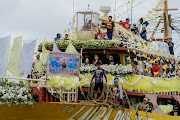
The Calatrava Women Weavers, renowned for their exceptional craftsmanship.
Calatrava is a town in northeastern Negros Occidental which proudly holds a rich tradition that has thrived for generations—the art of pandan weaving. This craft, tightly knit into the lives of Calatravahanons, has become a cornerstone of the community's cultural identity and economic livelihood.
The natural abundance of pandan plants (Pandanus amaryllifolius) all over the town has long supported its weaving industry. The people of Calatrava, particularly in Barangay Mahilum, have mastered the art of transforming raw pandan leaves into beautiful and functional items. The process begins with the careful harvesting of fresh pandan leaves, which are then stripped of their thorns and sliced into thin strips called "lilas." These strips are dried in the shade to maintain their pliability, as too much exposure to sunlight makes them brittle. For this particular reason, weavers choose to work inside the well-aerated caves on days when it is too hot to weave at home. Depending on which design they are working on, the “lilas” may be processed in their natural state or dyed in various colors before being woven into intricate patterns.
 Wild pandan plants grow all around Calatrava.
Wild pandan plants grow all around Calatrava.
Originally, the weavers of Barangay Mahilum relied on making traditional pandan mats, known locally as “banig”, as an extra stream of income to support their husbands. This changed when Neneng Dela Cerna, a weaver since her childhood, had an idea that would transition their products from a source of provision into a stepping-stone towards progression. With a background in dressmaking, Neneng has been creating bags out of pandan mats since her elementary days. On a fortunate day, an uncle of hers who sold “banigs” in the city excitedly came home with a woven handbag to show to the rest of the community. Inspired by such a beautifully crafted product, Neneng decided to make a dozen bags with her own designs that were immediately sold out, with an urgent demand for more. Surrounding local markets began selling them as native bags and orders started to flood, prompting Neneng to involve the entire barangay, including the men. She also generously shared her methods and techniques to a few other women who were willing to learn.
For a good decade or so, Barangay Mahilum leaned on the success of the sale of their bags, which were now making their way to the neighboring islands. The exponential leap came when Thelma “Timay” Canillo, one of Neneng’s first students, received a sizable order for a challenging design from a client in Hawaii. Aside from executing every detail to perfection, Timay went above and beyond by making smaller bags from the spare trimmings, which could then be sold as a set. The Indo Bag, as it is now known, has become the most successful product to come out of Calatrava, reaching other countries like Japan and Tahiti. Known for their durability and artistry, the Indo Bag’s success elevated their products from “native handicrafts” to “artisanal masterpieces”, while also significantly boosting the quality of life in Barangay Mahilum.
 The women weavers of Barangay Mahilum working inside a cave by the sea.
The women weavers of Barangay Mahilum working inside a cave by the sea.
The local government has played a vital role in supporting and promoting the weaving industry. Efforts to brand and market Calatrava’s pandan products have been essential to pursuing new heights. Collaboration with national organizations like the National Commission for Culture and the Arts (NCCA) has provided the weavers with training in packaging, branding, and innovation, ensuring that their products meet international standards and appeal to a global market. This is the town’s way of preserving its unique identity, and with it, finding a foothold in the international market.
Calatrava’s dedication to pandan weaving is celebrated annually in the Lilas Pandan Festival, held every June 29. With dancers clothed in pandan and excitement surrounding bag-making contests, this joyous event aims to engrave the importance of pandan weaving in the town’s cultural heritage and bring together the community in a celebration of their shared identity.
 The vibrant colors of Calatrava’s pandan handbags.
The vibrant colors of Calatrava’s pandan handbags.
Pandan-weaving in Calatrava is no longer simply a means of livelihood; it has become an industry that involves everyone, from parents to children, to government and markets abroad. This collective effort has ensured that the tradition remains alive and vibrant, with each generation contributing to its preservation, innovation, and growth. The weavers' commitment to quality has earned them a consistent customer base, with buyers returning for the unequaled craftsmanship that defines Calatrava’s pandan products.
As Calatrava looks toward the future with ambitions of achieving cityhood, the pandan-weaving tradition remains a focal point of its identity and economy. The weavers, supported by local government initiatives, continue to mend their stories through each strip of pandan, weaving not just mats or bags, but the very fabric of their community's story. This enduring tradition stands as a testament to the tight bond of the Calatravahanon people, ensuring that their heritage remains woven with the town's progress for generations to come.
Article and video script by: Liway Espina
Photos and video by: Unit A Creatives









